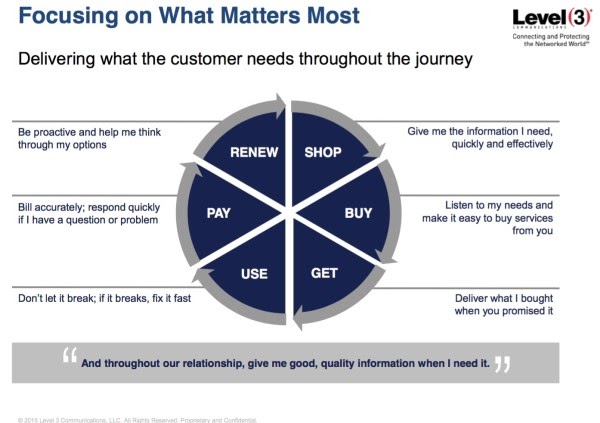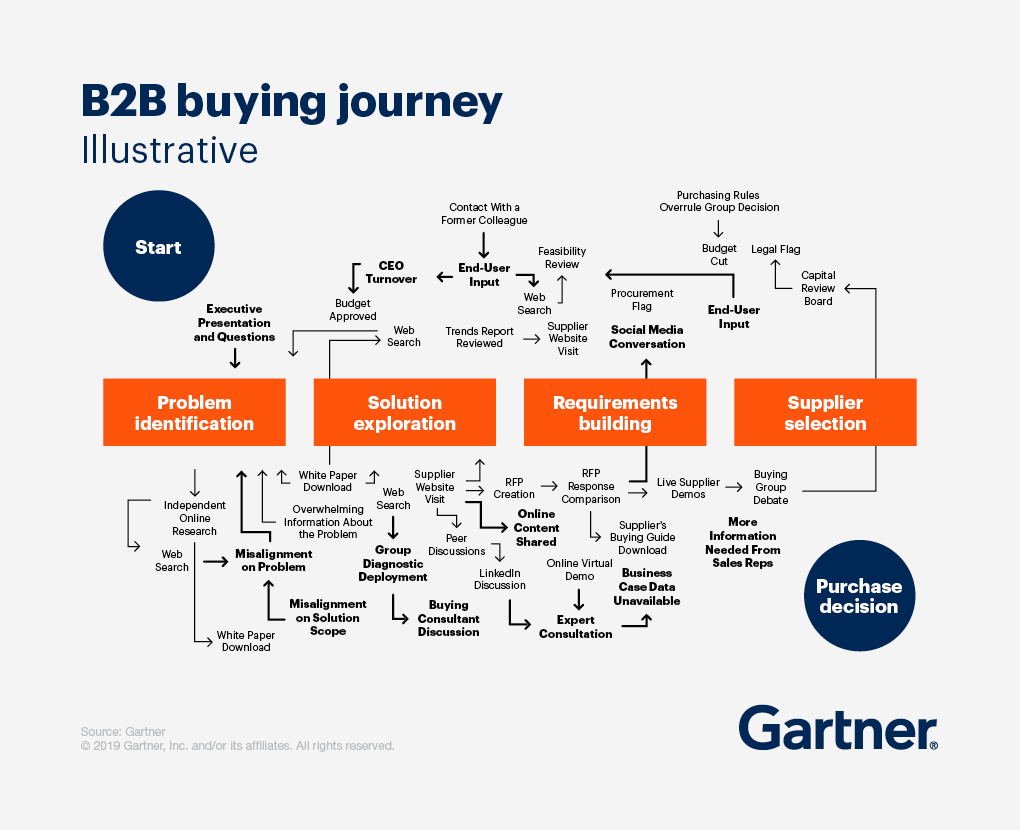The buyer’s journey seems simple: awareness, consideration, decision.
But implementing these steps requires a lot of planning and coordination. We’re diving into how and where to get started by sharing a few different frameworks so you can map your buyer journey to your sales process.
What is the buyer’s journey?
The buyer’s journey is an engagement model that takes a customer through three stages of evaluation before making a purchase. This framework asks sales and marketing to work together to provide buyers with the content they need at the right time in the sales process.
What are the three stages of the buyer’s journey?
The buyer’s journey typically includes three stages that a buyer cycles through before making a purchase: awareness, consideration, and decision. Let’s talk about each in more detail to understand their purpose in the buyer’s journey.
Awareness
The first stage aligns with the top of the sales funnel. The buyer knows they have a pain, but they aren’t sure what solutions are out there. The awareness stage is when your marketers should introduce your product, service, or company.
The content they see must help them understand what you do and how you can help them with their problem. Avoid talking about your brand or your products at this stage.
Consideration
The buyer has done research to figure out what solutions are available for their pain and goals. They have narrowed down a list of vendors that should fit their needs and are ready to engage with a sales rep.
This is the middle of the sales funnel, and your content needs to focus on persuasion and a commitment from your buyer to pursue a full evaluation. The type of content you provide can be much more product-based, but with a focus on the ROI and how your product can increase revenue.
Decision
The buyer has reached the bottom of the sales funnel and has chosen a vendor based on features, pricing, set up costs, and customer support. But the journey doesn’t end here. You still need to demonstrate competence and help them give you the formal “yes.” Your content should help them feel ready to deploy and includes case studies, product webinars, and technical guides.
Why is mapping a buyer journey important?
Buyers are not conducting evaluations in face-to-face meetings anymore. The content that you have available needs to capture the attention of digital buyers in every stage of the journey.
Since 72% of buyers will turn to google to search for solutions during the awareness stage, it’s important to have thought leadership and product content ready. Vendor comparison sites like G2 allow buyers to see how your product compares to your competitors; they’ll know if your company starts dropping the ball in features, support, or implementation.
Today’s decision-makers prefer to research and make the decision to purchase remotely. In fact, 99% of B2B buyers claim they would make a purchase entirely through a digital self-service model and are comfortable spending $50K or more.
The buyer’s journey also helps sales reps be more prepared, confident, and successful. Reps can expect higher quality engagement from their prospects and faster deal cycles. By providing customers with a better prospecting experience, reps can build trust with their knowledge and insights.
Are there buyer journey models?
There are a number of models out there so we’ve recommended three that are the best fit for B2B SaaS sales. These models will give you a framework to start mapping your customer journey to your sales process.
- Inbound Buyer’s Journey Model: Suitable for companies with straightforward product evaluations and a bigger focus on new business, rather than growing existing customer spend.
- Circular Model: Appropriate for companies with account-based sales and subscription models that must nurture a customer through their renewal date and beyond.
- Gartner’s B2B Buying Journey Model: Applicable for companies that have complex, big ticket evaluations with multiple decision-makers and long sales cycles.
Inbound Buyer’s Journey Model
HubSpot and IMPACT teamed up to create the inbound buyer’s journey that relies on the three stages of awareness, consideration, and decision. This model is a very straightforward approach to managing content in the buyer journey, especially if your business is focused primarily on acquiring new customers.
Your inbound sales reps need awareness content that helps establish them as trusted advisors without just promoting your brand. Your consideration and decision content then gives reps the tools to showcase their technical competence and their ability to understand their customers needs.

The types of content for each stage include:
Awareness:
- Thought leadership articles
- Educational blog posts
- Whitepapers, infographics, and ebooks
- Guides and checklists
- Explainer videos
- Industry reports
Consideration:
- Technical articles
- Competitor comparisons
- Live and recorded how-to webinars
- Product feature videos
Decision:
- Success stories, case studies, testimonials
- Product and pricing comparison documents
- Live, personalized demos
- Free trials
Circular model
Anthony Christie created the circular model that can work particularly well for B2B SaaS companies with high-value products or a subscription model. If your company has an account-based selling and marketing plan, the circular model can create consistency in your interactions – even if you have decision-makers who are in different stages of the evaluation.

The six stages of a buyer’s journey can be revisited when your customer wants to purchase additional products or increase your solution’s footprint in their organization.
Most importantly, the model makes it clear what matters the most: that the customer should expect empathy, accountability, and proactive support from your whole revenue team including sales, marketing, client support, and even finance.
Gartner’s B2B Buying Journey Model
Gartner’s buyer journey involves a lot of looping back to earlier stages or content. This is a realistic map for high-value, complex products – especially if you have an enterprise customer. There is no linear path if you have a lot of decision-makers at a target account with shifting priorities, leadership changes, and unexpected changes to requirements.

There are four stages in the Gartner model:
- Problem identification. The buyer(s) know they need to do something about their problem
- Solution exploration. The buyers put out feelers to see what kind of solutions are available in the market
- Requirements building. the buyers works with internal end-users to make sure that the strategic requirements are aligned with tactical needs
- Supplier selection. The buyers validate that the vendor they choose can provide what they need
How to tie your sales process to buyer journey
Once you have decided which model works best for your business, it’s time to map the sales process to the buyer journey. The sales funnel, marketing funnel, and your buyer journey are intertwined. The content you deliver to customers needs to provide value for marketers filling the funnel, and sales reps closing deals and expanding their accounts.
ICPs and personas
Before you can deploy the perfect buyer journey, you need to identify your ideal customer profile. Your ICP is the dream customer for your product and services and has the potential to consistently increase spend over time. So if you’re creating a lot of content but aren’t receiving quality leads, you’ve targeted the wrong people and are spinning your wheels.
The ICP helps you define and drive the right strategy at the start of your buyer journey. This is the company that will most likely purchase your product. To determine who your ICP is, use these key attributes:
- Industry
- Annual revenue
- Location
- Employee size
- Current subscriptions
The next step on your way to deploying a successful buyer journey is to identify buyer personas. These are the individuals at your ICP accounts that will be doing the buying. Creating these quasi-fictional characters helps sales reps relate to their buyers as real humans and informs your content creation strategy.
Your personas showcase the details about your potential client’s business interest, demographics, and even likes or dislikes. To determine which personas your reps and marketers need to target, use market research relevant to your industry – or even better – analyze the data you’ve collected about your existing customer base to identify why they were such a great fit.
Content creation
Now that you have your ICP and your buyer personas ready, you can start mapping your content to the buyer journey. When building your content strategy, use the data and tribal knowledge collected by sales and marketing to create content that resonates with your buyer.
Our webinar on How to Connect Your Sales Process and Buyer’s Journey provides five steps to get started:
- Determine what awareness, consideration, and decision mean for your sales funnel. Use your buyer personas to flesh out your answers.
- Identify where your product can add value. Again, use your personas to create content that is helpful for all of your key decision-makers.
- Create content and resources for awareness, consideration, and decision stages. Remember you need to deliver educational content, technical how-tos, and social proof, respectively.
- Validate that your content is hitting the mark by testing and modifying your content. Your high-performing reps can give you insight into the success of each piece of content.
- Don’t just give reps dozens or hundreds of content pieces and hope it works out. Train them on which content is most effective in each stage.
Measure your success
Don’t forget to measure the success of your buyer journey. These stats can help you tweak content if or when it isn’t working anymore. Key metrics to track the effectiveness of your content strategy include:
- Number of demos held
- Close rate
- Opportunity age (how long it takes to close a deal)
- Account revenue and retention
- Lifetime value of customer
Takeaway
Creating a smooth experience for your buyer is a perfect opportunity to use empathy, build trust, and show value. Learn more about creating an effective content strategy by aligning your personas and utilizing all marketing channels.



